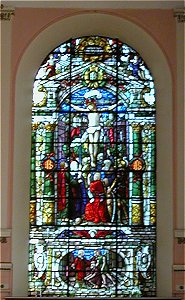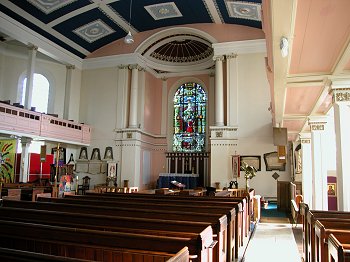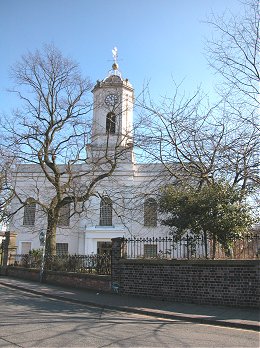|

St. Leonard's Church. |
One of the first mentions of a church in Bilston was in the reign of
Ethelred II (997) when the 'Chapel of Hampton' was founded and Bilston
is mentioned in the grant, (Shaw's 'Staffordshire'). There is no mention
of a church in 'Domesday' although by then Bilston was a good sized
village and was a Royal Demesne. It is known that a chapel existed in
Bilston in 1090 on the present site and that the priest was Robert
FitzStephen. Bilston remained a Royal Demesne until Henry II granted
Bilston to the Norman, Roger Wascellin, but in 1205 King John took it
back.
|
|
Bilston remained a possession of the crown until 1265
when Henry III granted the lands to Walter de Bilston for valour at the
Battle of Evesham.
Although Bilston was included in the 'Chapel of
Wolverhampton', due to its royal associations it was a 'free chapel' and
while most of the villages became Prebendal appendages, Bilston did not.
This is possibly the reason why Bilston was not mentioned in Deanery
documents until 1458. Three priests can be identified between 1265 and
1458.
The 'Staffordshire Assize Rolls' record that in 1287, Geoffrey de
Bilston was the priest.
A deed of the reign of Richard II in 1378, records gifts made by
Thomas Robyn and his wife, to William Poort 'ye priest of Bilstone'.
Shaw's 'Staffordshire' records that in 1435, Thomas le Clerk was
priest. |

The fine interior. |
|

The east window showing the
Crucifixion. |
In the reign of Henry VI, many chantries were founded, among them being
one founded in 1458 by Sir Thomas de Erdington Kt in Bilston Chapel, to be
called St Leonard's Chantry. There is a copy of the original charter
preserved by the Wrottesley family which mentions Thomas Hecock as Chantry
priest. A charter of Edward IV dated 1475 refers to Thomas Hecock as
perpetual priest of the Chapel of Bilston, probably indicating that he was
priest of both the Chapel and the Chantry. The charter mentioned, restores
some rights to the village taken away by Edward IV due to their support of
the Lancastrians during 'The War of the Roses' and now restored by the King.
Henry VII later confirmed this charter.
At the 'Dissolution of the Chantries', the Commissioners came to Bilston
in 1546. They recommended that the church be closed due to its small
income and 'the unlawful practices of the priest'. The lands were sold, but
the building was not demolished. |
|
Soon after the accession of Queen Mary in 1553, the
chapel was reopened, the Catholic Rite restored and Clement Perrye
appointed priest.
When Elizabeth came to the throne, the priest was John
Atte Lee who was at heart a Protestant and he firmly established the
Protestant doctrine.
He was followed by, among others, John Humfry Robbins,
Richard Perry, Thomas Baddeley, John Osborne, John Day and in March
1684, Richard Ames arrived in Bilston.
Ames is famous for his annotation of the Parish
Registers during his 46 years as priest at St Leonard's. He set himself
the task of recording everything that he could find that had happened
before he came to Bilston. He also recorded every item that came to his
notice about his parishioners. As a consequence, the two volumes written
during his years of office are among the most interesting and valuable
in the country.
|

A fine view of the church from across the
Midland Metro line. |
|

Another view of the interior. |
In his time, the chapel was enlarged, a priests house was built
and a burial ground consecrated in 1727. Although galleries had
been added in 1711, it was decided that a larger church was
needed. The Faculty for rebuilding was granted in 1729, but
unfortunately Ames did not live to see the new church which was
consecrated in 1733. When the old church was pulled down, the
base of the 14th century tower was found to be so solid that it
was incorporated into the new church. This church lasted for
quite a while but once again it was decided a larger church was
needed.
|
|
The body of the church was taken down except for the
tower as far as the ringing chamber, which once again was
allowed to remain. The new church, which is the present one, was
consecrated in 1826.
There have been some alterations since 1826. In 1883,
the walls of the church (which are brick) were encased in cement and the
tower faced with Grinshill stone.
Originally there were two pulpits, one each side of the
Sanctuary. In 1877 John Mason gave the brass lectern in memory of his
wife Sarah, so the South pulpit was then removed and some of the pews
against the East wall were also removed and replaced by choir stalls. In
1907 there was a gas explosion and the East window (The Resurrection)
was shattered, this was replaced by the present window (The
Crucifixion).
|

A view of the church from Walsall Street. |
|

The memorial to Samuel Holloway and his
wife. |
In 1951 a new Reredos was added to the altar, some pews
were removed, the choir stalls and the pulpit relocated and the present
enlarged Chancel was created. This is a memorial to the dead of World
War II.
More recently (1982) a wood and glass screen was built
across the back of the church to create a meeting room.
At the time of writing, a toilet block has been created
in the old choir vestry and a ramp added to the West door to allow
easier access for the disabled.
A church of St Leonard has stood on this spot in various
forms for some 900 years or so. When we have made sure that it is
structurally sound once again, we hope that it will remain here for
centuries to come
B. A. Lockley 2002
|
| This short history of the church
was gleaned from notes made in 1962 by Mr. R.N. Bissell who
chaired the then 'Records Committee'.
St. Leonard
6th (?) Century hermit.
He was a Frankish noble, converted to Christianity by St
Remigius. His godfather was Clovis king of the Franks. The king offered
him a Bishopric, but Leonard preferred to live as a hermit.
Clovis was hunting, accompanied by his pregnant wife.
She unexpectedly went into labor and the child and mother were saved by
Leonard's help and prayers.
In gratitude Clovis gave a large piece of land on which
he built the Abbey of Noblac, where Leonard became Abbot and where he
was buried.
After the 11th Century, he became one of the most
popular Saints in Western Europe. Most notable patronages are, pregnant
women and prisoners, especially prisoners of war. Bohemond, the
crusading Prince of Antioch, was released in 1103 from a Moslem prison
and subsequently visited Leonard's shrine at Noblec and made an offering
in gratitude for his release.
From 'The Oxford Dictionary of
Saints'
|

An early 20th century
postcard. Courtesy of Ralph Hickman. |

|
Return to
the
previous page |
|
|